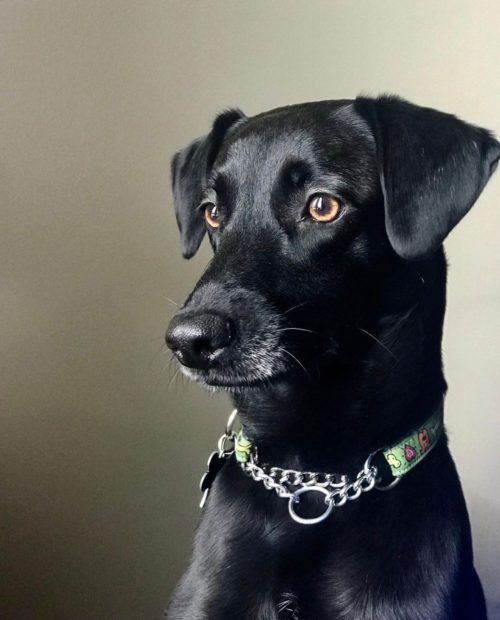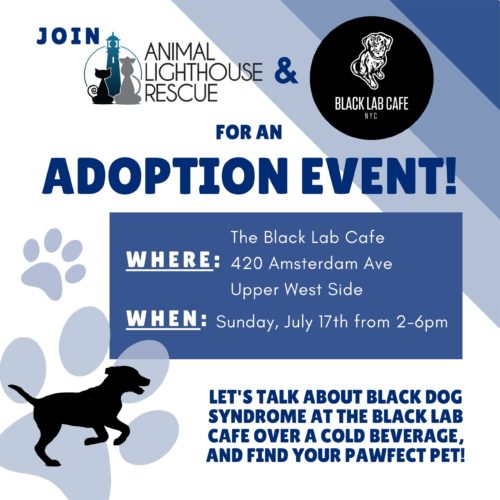
By Lisa Kava
You don’t have to be an animal lover to know that there are many dogs in shelters and in foster care who need forever homes. But fewer people may be aware of a phenomenon known in the dog rescue world as Black Dog Syndrome, where black dogs are often passed over, or take longer to get adopted than dogs with light- colored fur. According to Petfinder, the online pet adoption website, most pets are listed for 12.5 weeks until they get adopted, but black dogs spend almost four times as long on the site.
Animal Lighthouse Rescue (ALR) a non-profit organization which rescues stray dogs from the streets of Puerto Rico, and finds homes for them here in New York City, is trying to change that. The organization is hosting an event at Black Lab Café, on 420 Amsterdam Avenue (80th Street) on Sunday, July 17, from 2- 6PM. Adoptable black dogs will be in attendance. So will Upper West Sider and ALR volunteer Harry Leff, who will speak about Black Dog Syndrome in hope of providing education and awareness.
Stray dogs in Puerto Rico are known as “satos,” by locals. Prior to Hurricane Maria in 2017, there were approximately 200,000 satos in Puerto Rico. Today there are an estimated 500,000. Animal Lighthouse Rescue partners with a shelter in Humacao, Puerto Rico called El Faro de Los Animales to provide medical care, socialization and, ultimately, transportation to New York City for the dogs.
“We at Animal Lighthouse Rescue experience Black Dog Syndrome as most rescues and shelters do. Our black rescues take a longer time to get adopted and spend a much longer time in foster care,” Tania Isenstein, Chair of the Board of ALR told West Side Rag. Isenstein is the former owner of Camp Canine, a dog day care, boarding and grooming facility at 46 West 73rd Street.

Rescue group leaders say that black dogs often do not come across well in photographs. “We do our best to take excellent pictures of the black dogs which can help. Sometimes we hire a professional photographer,” Isenstein said.
Jane Moskowitz, founder of Cunucu Dog Rescue, witnesses Black Dog Syndrome regularly. “Most of our black puppies take many weeks to be adopted. It usually has to do with the fact that they don’t tend to photograph as well,” Moskowitz confirmed.
The way black dogs are portrayed in the media may also contribute to Black Dog Syndrome. “In film and television, many times, black dogs are portrayed as aggressive. Dobermans or Rotweillers are often the growling attack dogs protecting villains or secluded areas,” according to the website Cesar’s Way, founded by renowned dog trainer Cesar Millan. The Petfinder site points out that a big frightening black dog is even seen on the common “Beware of Dog” sign.

“I had heard black dogs were adopted less often, so it was part of my decision to choose JJ when I visited Bideawee’s shelter. He’s been a wonderful addition to our family,” says Joy Bergmann. “Though he’s a large mix, most people respond lovingly toward him. His prancing gait gets a lot of smiles. The only downside to his black fur is that he overheats a bit more quickly than other dogs might during the summer.”
“We are working out details with Black Lab Café to make use of the outdoor and indoor space for our meet- and-greet and sharing of information about ALR and Black Dog Syndrome,” Leff told the Rag. “We are planning for now to have only black dogs at the event. But we may add to the mix if we have dogs of other colors ready for adoption.”
Advanced registration is not required to attend the adoption event on Sunday, everyone is welcome. ALR does not do “on-the-spot,” adoptions, rather potential adopters are vetted by adoption counselors. Those interested in adopting a dog can fill out an application here.
“We hope that we can bring awareness to Black Dog Syndrome, and start the conversation to make change,” Isenstein said.










The well-discussed phenomenon of black dog syndrome has been studied repeatedly: most studies find no or little effect of coat color on adoption rates. (Here’s an example: https://www.tandfonline.com/doi/abs/10.1080/10888705.2013.740967). That said, as a person who has lived with multiple black-coated dogs, I’m all for black-dog adoptions, for their own sake…
Unfortunately, our adoptable black dogs at ALR take much longer to adopt out than dogs of other colors of equal size, temperament and with equally great pics, like Lola. I wish that were not the case! Hope to see you at the event!
Adoption events are nice. But, given the statistics, rescue-by-transport barely scratches the surface. The article notes there are 500,000 stray dogs in PR, whose human population is around 3 million and average household size is around 3 people. It is uneconomical to fly/ship out 500,000 dogs and unfeasible that 1 of every 2 PR households adopt a stray. Perhaps any funds are better spent on catch-and-release sterilization programs locally. Also consider adoption vacation programs whereby potential adopters travel to PR to meet and return home with their dream dog. Such trips will provide jobs and income to boost the local PR economy and may result in fewer strays, as surely one reason for the increase in strays is lack of affordability to keep a dog.
P.S. I’ll try to make my next dog black.
Thank you for your feedback. This issue in Puerto Rico is indeed alarming and complex, & we are committed to help. We partner with organizations to transport dogs (e.g., The Sato Project, Wings of Rescue). It’s not cheap to do this; we feel strongly about bringing the resources we have here in the NYC area to do what we can for the beleaguered island lacking those resources. We also work the Humane Society on Spay-a-Thons for both owners who would not do it otherwise as well as strays (catch & release). (https://www.humanesociety.org/spayathon) We also work with hotels & resorts – the Wyndham at Rio Grande and Palmas del Mar, both located near our sister shelter, El Faro de los Animales (https://www.elfaropr.org/) have instituted the vacation programs you suggest (https://palmasanimalwelfare.org/, https://www.facebook.com/SoulBahiaPR/). We are working on partnering with more. We also work with local schools to educate the next generation & sponsor volunteer programs at the shelter. (When I was there earlier this week, a mother and son volunteered for the afternoon which was amazing to see.)
Even with the complexity of the issue, we adhere to this philosophy: Saving one dog will not change the world, but surely for that one dog, the world will change forever. So glad to hear that you may adopt in the future – and a black dog at that!
Lola is 😍😍😍and for what it’s worth, I never ever heard of Black Dog Syndrome…I would have literally expected to find this phrase in one of your “Absurdities” columns… I myself have always preferred black dogs for some reason, but it’s also true that my own did indeed suffer in the summer on the horrendously hot NYC sidewalks. I hope that Lola and friends will find their forever homes very soon!
My last dog was black and loved sun bathing! Never really understood it, but he just adored the sun!
I can attest to Black Cat Syndrome, too. My dad and I visited several shelters recently in search of a kitten for him, and every single one of them said that the black kittens are passed over regularly and spend about 3x as long at the shelter as lighter colored cats. The whole “black cat superstition” doesn’t help, but it’s literally just a made up thing and these cats are just as lovely and sweet as any other.
Note: My dad ending up adopting the sweetest black kitten, for what it’s worth! 🙂
Does anyone know what the organization’s adoption fee is? I looked on the site, and while the adoption application is easily accessible, the information on fees is not
Thanks for asking Penny. The adoption fees can vary – from $250 to $500 depending on the type (cat or dog) and spay status. If you are interested in more information, please email us at info@alrcares.com.
Our 11 year old black lab-beagle-who-knows-what rescue mix granddog is the sweetest dog you’d ever want to meet. Rescued as a puppy, she is gentle with toddlers, loving with grandparents, loyal, playful, and sweet. This syndrome is shameful.
We have always had big black dogs. We did not go out to specically choose a color; we had never heard of black dog syndrome. My cat-owner friends have chosen black cats because they are hard to place by adoption agencies because of the superstition But Black Dogs? I have never heard of a superstition about black dogs crossing my path.
Why would anyone reject a pet because of its color. In agreement with NYYgirl, yes black dogs suffer more in the summer in New York, but that has only hindered my elderly dog for long walks. And, although not as much, light colored dogs also suffer in the heat.
Point: choosing a dog, cat,( or person for that matter), by color should never be the criteria. Those who do reject black dogs, cats or people are missing out on rewarding relationships
I can attest to the fact that black puppies don’t photograph as EASILY (I wouldn’t say well), though now that we can instantly see our photos, that shouldn’t really be an issue. I was on film rolls when I had a black puppy. And yes, I CHOSE her. Could have chosen any number of other breeds or colors.
If someone wants a dog simply for being photogenic, they may not ought to have that dog.
Let’s not take “black” too far now…..
We are coming up on our 2 year anniversary with Rubi from Lighthouse. She is a light colored dog. She is a great dog and Lighthouse is an amazing organization. While I now have 2 light colored dogs, I miss my dark brindle almost unadopted one. A distinct benefit of a black/dark colored dog is that they stay (or at least look 🙂 cleaner longer!
I have only ever adopted black cats and intend to continue doing so. It seems, in part, like a matching issue– I have had difficulty locating black cats. Isn’t there an organization that rescues black cats exclusively, and works to match them with owners who only want black cats?
As for dogs, they’re all pitbull mixes. Get a cat instead.
As someone who has owned and loved black cats, and think they are beautiful, I think part of the reason is that black fur gets all over your clothes and furniture and is a real pain to keep clean. Light-colored fur likewise needs to be cleaned but is less noticeable if you choose to not clean for a day or two.
Hi, Becky, I have to disagree about your comment on black fur. I think it’s really the other way around. I had a beautiful tuxedo cat for over 17 years until he succumbed to kidney disease and his hair was NEVER as noticeable on furniture or clothing as my dog’s hair was. My dog was a mixed spaniel/shepherd with mostly short silky reddish hair. His hair was ALWAYS visible during shedding season. I also once had a white Chihuahua whose hair seemed to be almost magnetically drawn to everywhere in the house all year round. All were the loves of my life and I miss them every day, but I now have another all-black cat and again notice that the hair is just not as noticeable. Maybe it’s the type of material your furniture is made from?